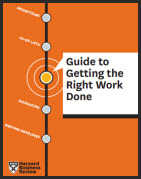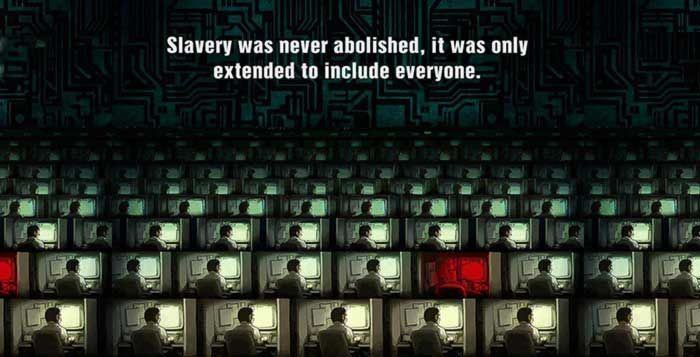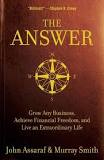Guide to Getting the Right Work Done

 Guide to Getting the Right Work Done
Guide to Getting the Right Work Done
– Harvard Business Review
(My Personal Notes)
How to Stay Focused on What’s Important
- Choose three important tasks to complete each day.
Write them down on a slip of paper, and keep it visible. Instead of checking your e-mail, look at the slip of paper and work on an item. Keep the list to just three tasks, and see how many you can complete. - Turn off your e-mail until your tasks are done.
- Set up a “Weekly Review” 20-minute meeting with yourself.
Put it on your calendar, and don’t book over it. Go somewhere to be alone. Bring your project list, to-do list, and calendar, and spend the time reviewing what you finished in the past week, and what you want to get done next week. This is a great time to choose your daily three important tasks.
The Worth-Your-Time Test
When someone comes to you with a request, ask yourself three questions:
- Am I the right person?
- Is this the right time?
- Do I have enough information?
If the request fails the test—if the answer to any one of these questions is “no”—then don’t do it.
- Pass it to someone else (the right person)
- Schedule it for another time (the right time), or
- Wait until you have the information you need (either you or someone else needs to get it).
An 18-Minute Plan for Managing Your Day
STEP 1
(5 Minutes):Set Plan for Day.
- Before turning on your computer, sit down with a blank piece of paper and decide what will make this day highly successful. What can you realistically accomplish that will further your goals and allow you to leave at the end of the day feeling like you’ve been productive and successful?
- Write those things down.
- Now, most important, take your calendar and schedule those things into time slots, placing the hardest and most important items at the beginning of the day (before even checking your e-mail).
- If your entire list does not fit into your calendar, re-prioritize your list.
- If you want to get something done, decide when and where you’re going to do it. Otherwise, take it off your list.
STEP 2
(1 minute every hour): Refocus.
- Set your watch, phone, or computer to ring every hour. When it rings, take a deep breath, look at your list and ask yourself if you spent your last hour productively.
- Look at your calendar and deliberately recommit to how you are going to use the next hour. Manage your day hour by hour. Don’t let the hours—or the inevitable interruptions—manage you.
STEP 3
(5 minutes at end of day): Review.
- Shut off your computer and review your day. What worked? Where did you focus? Where did you get distracted?What did you learn that will help you be more productive tomorrow?
How to Write To-Do Lists That Work
1. Break it down.
- Then break it down some more.
- Don’t confuse to-do’s with goals or projects.
- A to-do is a single, specific action that will move a project toward completion. It’s just one step.
- For example, “Plan the committee lunch” is a project. “E-mail Karen to get catering contact” is a to-do. In this case, the action of e-mailing Karen is a simple, two-minute undertaking—something small and innocuous that you can do without thinking.
- After it’s done Add the next step to your list.
Breaking down your task to the smallest possible action forces you to think through each step up front. With the thinking out of the way, it’s easy to dash off that e-mail, make that call, or file that report, and move your work along with much less resistance.
2. Use specific action verbs and include details.
- Your teeth are overdue for a cleaning, but the “Make a dentist appointment” to-do just hasn’t gotten done.
- When you write down that task, use an action verb (call e-mail?) and include whatever details your future self needs to check it off. “Call Dr. M. at 555-4567 for a cleaning any time before 11 am on January 17, 18, or 19” is a specific, detailed to-do.
- Your to-do list is your way of assigning tasks to yourself, so be as helpful to yourself as you would be to a personal assistant.
- Make your to-do’s small and specific to set yourself up for that glorious moment when you can cross them off the list as DONE.
The Art of the Self-Imposed Deadline
Here’s how to create your own deadlines so that you accomplish more—more easily
Start your day as early as possible.
- Even if you’re not a morning person, there’s something intoxicating about planning to do A and B, and then discovering you’ve done A, B, and C by noon.
- Seeing C in the rear-view mirror at lunch also makes D and E look a lot more inviting—and Q not so far out of reach.
Tackle similar small tasks back-to-back.
- That’s what gets you on a roll.
- The mind thrives on repetition, at least to a point.
- Three things done by noon is ecstasy.
Avoid the curse of the “final push.”
- Divide up a project so that the longest part is the first part, the next longest is the second, and so on.
- If each part gets smaller as you go, the end will come faster—or at least it will feel like that, which is the point.
- If the long parts are near the end, you’ll feel worn out before you reach the finish.
Manage Your Energy, Not Your Time
PHYSICAL ENERGY
- Enhance your sleep by setting an earlier bedtime and reducing alcohol use.
- Reduce stress by engaging in cardiovascular activity at least three times a week and strength training at least once.
- Eat small meals and light snacks every three hours.
- Learn to notice signs of imminent energy flagging, including restlessness, yawning, hunger, and difficulty concentrating.
- Take brief but regular breaks, away from your desk, at 90 to 120 minute intervals throughout the day.
EMOTIONAL ENERGY
- Defuse negative emotions—irritability, impatience, anxiety, insecurity— through deep abdominal breathing.
- Fuel positive emotions in yourself and others by regularly expressing appreciation to others in detailed, specific terms through notes, e-mails, calls, or conversations.
- Look at upsetting situations through new lenses.
Adopt a “reverse lens” to ask, “What would the other person in this conflict say, and how might he be right?”
Use a “long lens” to ask, “How will I likely view this situation in six months?”
Employ a “wide lens” to ask, “How can I grow and learn from this situation?
MENTAL ENERGY
- Reduce interruptions by performing high-concentration tasks away from phones and e-mail.
- Respond to voice mails and e-mails at designated times during the day.
- Every night, identify the most important challenge for the next day. Then make it your first priority when you arrive at work in the morning.
SPIRITUAL ENERGY
- Identify your “sweet spot” activities—those that give you feelings of effectiveness, effortless absorption, and fulfillment. Find ways to do more of these.
- Allocate time and energy to what you consider most important. For example, spend the last 20 minutes of your evening commute relaxing, so you can connect with your family once you’re home.
- Live your core values. For instance, if consideration is important to you but you’re perpetually late for meetings, practice intentionally showing up five minutes early for meetings.
Source: Guide to Getting the Right Work done [.PDF]



![Van Hunting journey & Why I ended up with HomeR – Van-Life #04 [Video]](https://old.pennybutler.com/wp-content/uploads/2015/03/04-van-hunting-blog.png)
